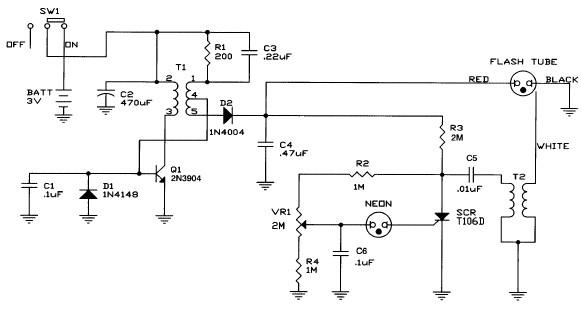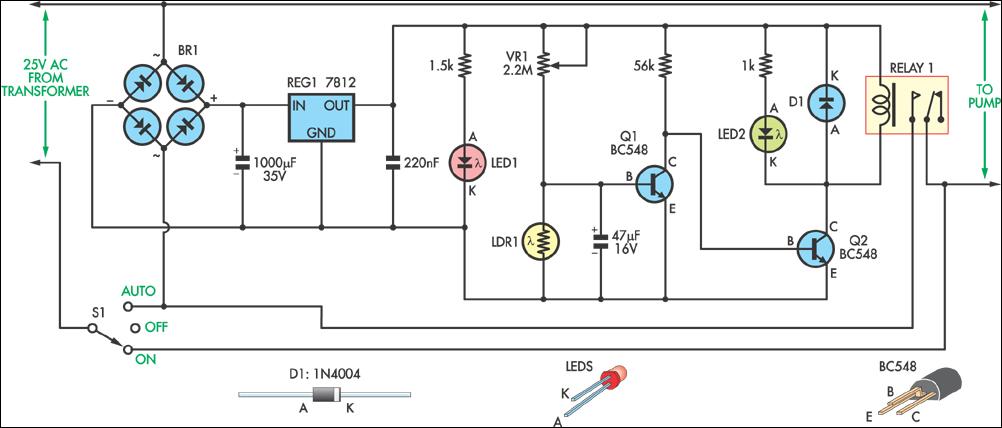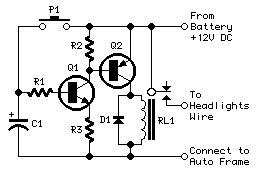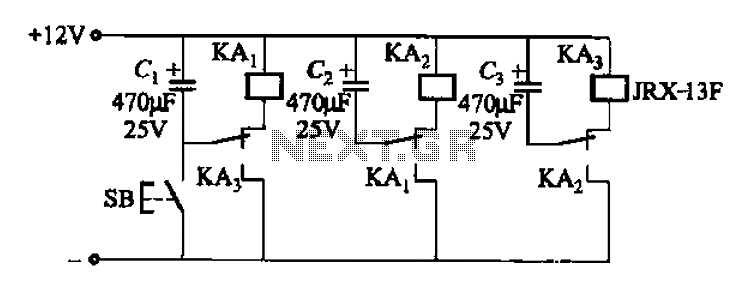
Rear Light After Glow (For Bicycles)

This article is relevant only to readers whose bicycle lights are powered by a dynamo. The regulations regarding bicycle lights in the United Kingdom are stricter than in other countries, making the use of a dynamo uncommon in this region. From a traffic safety perspective, it is advisable (and in the UK, mandatory) for cyclists to have their rear lamp illuminated even when stationary. Modifying the existing rear light to include an afterglow feature is not particularly complex; it simply requires a sufficiently large energy reservoir. Since the afterglow is needed only for short intervals, a battery is unnecessary; a capacitor with a large capacitance, such as 1 F, is adequate. The circuit diagram illustrates that the standard rear light bulb is replaced with two series-connected bright LEDs, D2 and D3, which are clearly visible with a current of only 6 mA (in contrast to the 50 mA required by the bulb). The current is regulated by series resistor R1. The LEDs are connected in parallel with the 1 F capacitor, C1. Given that the working voltage of this capacitor is only 5.5 V, it remains physically compact despite its high capacitance. An effective voltage regulator is necessary to adequately limit the dynamo voltage. Standard regulators are unsuitable for this application as they do not function at low voltages and would discharge the capacitor when the bicycle is stationary. Fortunately, a low-dropout regulator, the Type LP2950CZ5.0, fulfills the requirements effectively. The dynamo output voltage must be rectified before being fed into the regulator. In this circuit, this is achieved using half-wave rectifier D1 and buffer capacitor C2. Diode D1 is a Schottky type to minimize losses, which is crucial for this application, as grounding through the bicycle frame can introduce additional losses. The buffer capacitor's value has been selected to exceed the minimum requirements, ensuring that C1 is charged during the negative half-cycles of the dynamo voltage.
The circuit described integrates several components to create an efficient lighting system for bicycles powered by a dynamo. The use of two series-connected bright LEDs (D2 and D3) as replacements for the traditional rear light bulb not only reduces power consumption but also enhances visibility. The series resistor (R1) is critical for limiting the current flowing through the LEDs, ensuring that they operate within safe parameters while providing adequate brightness.
The 1 F capacitor (C1) serves as the energy reservoir, allowing for a brief afterglow when the bicycle is stationary. This capacitor is charged during the operation of the dynamo, which generates alternating current (AC) that is rectified by the Schottky diode (D1). The choice of a Schottky diode is significant due to its low forward voltage drop, which helps to minimize power losses, thus maximizing the efficiency of the system.
The LP2950CZ5.0 low-dropout voltage regulator is employed to maintain a stable output voltage, ensuring that the LEDs receive constant power regardless of fluctuations in the dynamo output. This regulator is particularly suited for applications requiring low input-output voltage differentials, making it ideal for use with the low voltage generated by the dynamo.
In summary, this circuit design effectively addresses the need for a reliable and energy-efficient rear light system for bicycles powered by a dynamo, adhering to UK regulations while enhancing safety for cyclists. The integration of modern components such as LEDs and low-dropout regulators reflects an advancement in bicycle lighting technology, promoting both functionality and energy efficiency.This article is of interest only to readers whose bicycle lights are powered by a dynamo. The laws on bicycle lights in the United Kingdom are stricter than in other countries and a dynamo is, therefore, a rarity in this country. From the point of view of traffic safety it is advisable (in UK obligatory) for cyclists to have the rear lamp of their
bicycle to light even when they are at standstill. In principle, it is not very difficult to modify the existing rear light with afterglow: all this needs is a large enough energy reservoir. Since the after-glow is required for short periods of time only, a battery is not required: a large value capacitor, say, 1 F, is quite sufficient.
As the diagram shows, in the present circuit, the normal rear light bulb is replaced by two series-connected bright LEDs, D2 and D3. These are clearly visible with a current of only 6 mA (compared with 50 mA of the bulb). The current is set with series resistor R1. The LEDs are shunted by the 1 F capacitor, C1. Since the working voltage of this component is only 5. 5 V, it is, in spite of its high value, physically small. An effective regulator is needed to limit the dynamo voltage adequately. Normal regulators cannot be used here, since they do not work at low voltages. Moreover, such a device would discharge the capacitor when the cycle is at standstill. Fortunately, there is a low-drop type that meets the present requirements nicely: the Type LP2950CZ5.
0. Of course, the dynamo output voltage needs to be rectified before it can be applied to the regulator. In the present circuit, this is effected by half-wave rectifier D1 and buffer capacitor C2. Diode D1 is a Schottky type to keep any losses low important for this application, because the ground connection via the bicycle frame usually causes some losses as well.
The value of buffer capacitor has been chosen well above requirements to ensure that C1 is charged during the negative half cycles of the dynamo voltage. 🔗 External reference
The circuit described integrates several components to create an efficient lighting system for bicycles powered by a dynamo. The use of two series-connected bright LEDs (D2 and D3) as replacements for the traditional rear light bulb not only reduces power consumption but also enhances visibility. The series resistor (R1) is critical for limiting the current flowing through the LEDs, ensuring that they operate within safe parameters while providing adequate brightness.
The 1 F capacitor (C1) serves as the energy reservoir, allowing for a brief afterglow when the bicycle is stationary. This capacitor is charged during the operation of the dynamo, which generates alternating current (AC) that is rectified by the Schottky diode (D1). The choice of a Schottky diode is significant due to its low forward voltage drop, which helps to minimize power losses, thus maximizing the efficiency of the system.
The LP2950CZ5.0 low-dropout voltage regulator is employed to maintain a stable output voltage, ensuring that the LEDs receive constant power regardless of fluctuations in the dynamo output. This regulator is particularly suited for applications requiring low input-output voltage differentials, making it ideal for use with the low voltage generated by the dynamo.
In summary, this circuit design effectively addresses the need for a reliable and energy-efficient rear light system for bicycles powered by a dynamo, adhering to UK regulations while enhancing safety for cyclists. The integration of modern components such as LEDs and low-dropout regulators reflects an advancement in bicycle lighting technology, promoting both functionality and energy efficiency.This article is of interest only to readers whose bicycle lights are powered by a dynamo. The laws on bicycle lights in the United Kingdom are stricter than in other countries and a dynamo is, therefore, a rarity in this country. From the point of view of traffic safety it is advisable (in UK obligatory) for cyclists to have the rear lamp of their
bicycle to light even when they are at standstill. In principle, it is not very difficult to modify the existing rear light with afterglow: all this needs is a large enough energy reservoir. Since the after-glow is required for short periods of time only, a battery is not required: a large value capacitor, say, 1 F, is quite sufficient.
As the diagram shows, in the present circuit, the normal rear light bulb is replaced by two series-connected bright LEDs, D2 and D3. These are clearly visible with a current of only 6 mA (compared with 50 mA of the bulb). The current is set with series resistor R1. The LEDs are shunted by the 1 F capacitor, C1. Since the working voltage of this component is only 5. 5 V, it is, in spite of its high value, physically small. An effective regulator is needed to limit the dynamo voltage adequately. Normal regulators cannot be used here, since they do not work at low voltages. Moreover, such a device would discharge the capacitor when the cycle is at standstill. Fortunately, there is a low-drop type that meets the present requirements nicely: the Type LP2950CZ5.
0. Of course, the dynamo output voltage needs to be rectified before it can be applied to the regulator. In the present circuit, this is effected by half-wave rectifier D1 and buffer capacitor C2. Diode D1 is a Schottky type to keep any losses low important for this application, because the ground connection via the bicycle frame usually causes some losses as well.
The value of buffer capacitor has been chosen well above requirements to ensure that C1 is charged during the negative half cycles of the dynamo voltage. 🔗 External reference





